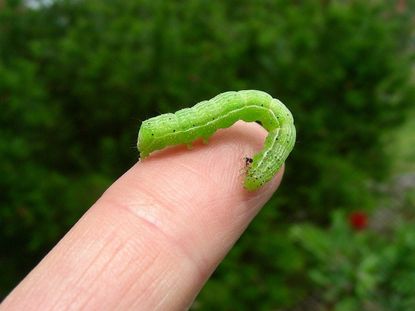Cabbage Looper Control: Information On Killing Cabbage Loopers


If you see green, fat-bodied caterpillars on your cabbage that move like little drunks, you probably have cabbage loopers. Cabbage loopers are so named because of their looping, wobbly movement. Cabbage looper pests are common on all cruciforms in the United States, Canada, and Mexico. Killing cabbage loopers is essential to an attractive crop, free of holes and rotting spots. Learn how to get rid of cabbage loopers with chemical or mechanical means.
About Cabbage Looper Pests
Cabbage loopers have up to seven instars. The larvae mature to thick green caterpillars with a white stripe running along either side. They have five pairs of prologs and a cigar shaped body, which is thinner at the head end. By the time the larvae reaches maturity, it may be as much as 2 inches (5 cm.) long. Once the looper pupates, it becomes a grayish brown moth. The larvae have chewing mouthparts, which damage foliage on a wide range of plants. The chewing behavior leaves foliage tattered and ragged with jagged edges. Cabbage looper control and management helps ensure the vitality of your plants. Leaf damage minimizes the ability of a plant to gather solar energy.
How to Get Rid of Cabbage Loopers
The easiest, most accessible, and safest way to get rid of cabbage looper pests is by manual removal. The caterpillars are big enough that you can easily spot them. Look in the morning and late evening when temperatures are cool. Pull off the icky little things and dispose of them. (I leave the details up to you, but see to it that they don't reach adulthood.) Look for eggs on the underside of plant leaves and scrape them off gently. Eggs are ridged and laid in rows along the undersides of leaves. Preventing the next generation is a great way of killing cabbage loopers. Avoid the use of broad range pesticides, which will also kill beneficial predators. Whenever possible, use organic cabbage looper pesticides if you wish to use chemical warfare.
Cabbage Looper Control
It is best to use organic cabbage looper pesticides on food crops. They are safer and do not kill most beneficial insects. Bacillus thuringiensis (Bt) is an organic bacterium, which occurs naturally in soil. Pesticides with spinosad are also effective and safe, with little impact on beneficial insects. The best results are obtained by early application when larvae are small. Check the undersides of leaves every week for signs of cabbage looper pests. Visual cues, such as ragged leaves, are also a good indicator that it is time to spray with organic cabbage looper pesticides. Consistent cabbage looper control will gradually reduce the incidence of the pests in your garden.
Gardening tips, videos, info and more delivered right to your inbox!
Sign up for the Gardening Know How newsletter today and receive a free download of our most popular eBook "How to Grow Delicious Tomatoes."

Bonnie Grant is a professional landscaper with a Certification in Urban Gardening. She has been gardening and writing for 15 years. A former professional chef, she has a passion for edible landscaping.
-
 Grow a Bathroom Oasis: 8 Best Bathroom Plants With No Light or Low Light
Grow a Bathroom Oasis: 8 Best Bathroom Plants With No Light or Low LightSome apartment dwellers grow the best bathroom plants with no light or low light. Read how one of our favorite plant lovers does it in the big city.
By Teo Spengler
-
 "My Worst Mistake" – Gardeners Share 10 Hard-Learned Lessons
"My Worst Mistake" – Gardeners Share 10 Hard-Learned LessonsGardeners never stop learning, and sometimes our mistakes are the best teachers. But why not save time and heartache by learning from other gardeners' failures?
By Melanie Griffiths